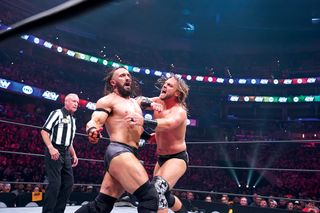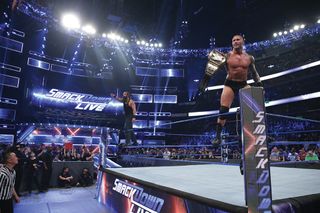Wrestling Flies High on TV Again
In a Battle Royale reminiscent of the 1990s pro-wrestling wars, USA Network and WWE are facing a legitimate challenge to their decades-long reign as pro wrestling’s heavyweight champions. TNT last Wednesday (Oct. 2) officially stepped back into the squared ring with All Elite Wrestling: Dynamite, a weekly TV series from upstart All Elite Wrestling. And USA and WWE hit right back, going head-to-head against Dynamite with a series of their own, WWE NXT.
While TNT’s AEW franchise and USA’s WWE NXT series going head to head for viewers on Wednesday nights, industry observers say the pro-wrestling genre is a content champion for networks looking to pin down younger cord-cutters and cable-nevers with action-packed, live sports entertainment programming.

“The way to combat the increase in streaming is to offer live event programming, and if that programming is sports content targeted to young men, then you’ve hit the trifecta,” media consultant Bill Carroll said. “Pro wrestling provides that across 52 weeks a year of live primetime programming that, in essence, regenerates itself.”
Appointment TV
USA, TNT, Fox and independent AXS TV (the new home to Impact Wrestling) are betting that loyal, young male viewers will tune into pro-wrestling programming to root for their favorite, athletically-inclined heroes and masked villains as they jump off of ring ropes, slam into tables and get thrown into corner ring posts. Wrestling’s value to TV networks in this hyper-competitive video era was underscored by WWE’s lucrative new deals with USA parent Comcast NBCUniversal and with Fox last year, and by AT&T-owned WarnerMedia’s investment in AEW.
“Wrestling has survived the war of attrition with regard to programming formats [while] primetime dramas and sitcoms have suffered major audience drop-offs in recent years,” sports analyst Lee Berke said. “The only genre that has maintained some sort of viewership appeal has been wrestling. It is name-brand sports-themed content that has perennially drawn linear TV viewers.”
Leading the genre’s charge has been WWE, whose long-running Monday Night Raw and SmackDown franchises offer new episodes every week of the year. In fact, Raw is television’s longest-running weekly episodic program ever, with 1,375 episodes since its 1993 debut. The show has averaged between 4 million and 5 million viewers over its 26-year run, per Nielsen live-plus-seven-day ratings.
Multichannel Newsletter
The smarter way to stay on top of the multichannel video marketplace. Sign up below.
WWE co-president Michelle Wilson said the success of Raw and the 20-year-old SmackDown franchise — the retitled Friday Night SmackDown moved to Fox Oct. 4 after a three-year run Tuesday nights on USA — has been based on the WWE’s ability to market and promote its product across shows and platforms.
“We’ve cracked the code on how to successfully cross-promote to drive audiences from show to show, whether it’s to a specific network or platform,” Wilson said. “We love the fact that being on Monday nights on USA we can drive the audience to Wednesdays on USA and now to Fridays on Fox.”
It also helps to have big-name stars that transcend wrestling, from Hulk Hogan in the 1980s to, more recently, Dwayne “The Rock” Johnson and John Cena. The Rock, along with other WWE alumni, were scheduled to help bring wrestling fans to SmackDown for its Fox premiere, which marked 20th anniversary of the live, two-hour show.
“Since we announced our five-year agreement [with the WWE for SmackDown] last June, we have been eagerly counting down the days to the launch of SmackDown Live on Fox Sports,” Fox Sports CEO and executive producer Eric Shanks said.
WWE president Wilson said SmackDown’s over-the-air exposure on Fox will provide additional promotion for the company’s other weekly cable shows, including NXT, the series that launched this past Wednesday [Oct. 2] on NBCUniversal-owned USA.
“We have the opportunity on broadcast television to reach 110 million households where we can promote NXT Wednesday nights and back to Raw on Monday nights,” Wilson said. “For us, we love that across all three shows — and then reinforced with our 1 billion social media followers around the world — we can promote all three brands.”
TNT hopes to cut into the WWE’s stranglehold on the genre with All Elite Wrestling, the first pro wrestling content on the network since 2001 when it aired the Turner-owned World Championship Wrestling’s WCW Monday Nitro series directly against Monday Night Raw. Then-Turner parent AOL Time Warner eventually sold WCW’s assets to WWE in 2001.
“AEW sets out to be wrestling’s sports-centric brand, with a huge emphasis on quality of life for talent,” AEW executive vice president Cody Rhodes, also an in-ring performer, said. “[The WWE] loves to say they are sports entertainment, and that’s what they’ve marketed and done so well. We’re going in a completely different route … it’s almost like you’re watching the UFC or a boxing event.”
TNT senior vice president of original programming Sam Linsky said the live, action-packed content of pro wrestling fits well with the TNT brand, which includes live National Basketball Association games and marquee movies.
Along with TNT’s weekly airing of AEW: Dynamite, the Turner Sports-owned streaming service Bleacher Report Live will also carry AEW’s pay-per-views and other special event programming, according to AEW chief brand officer Brandi Rhodes.
“Wrestling has been a monopoly for 20 years … fans are actually craving some different styles and different ways of presenting wrestling,” Linsky said. “We have such a great history here, it felt like a natural match on network that has a lot of sports and high-octane movies, and is really known historically for being part of the wrestling [genre].”
In the other corner on Wednesday nights is WWE NXT, which was created in 2014 for its then upstart streaming service WWE Network. The live, two-hour NXT series also made its USA debut Oct. 2.
“I just love the brand of NXT,” USA Network and Syfy president Chris McCumber said. “They have this kind of fight cult feel to it as if you’re in the club. We’re all about investing in passionate clubs and passionate fans, and NXT is definitely part of that.”
Added Wilson: “From an advertiser/ratings perspective, we know that its reaching a younger, more male audience, so that is unique positioning The brand is a little grittier and edgier to appeal to that audience specifically.”
In their first head-to head matchup, AEW: Dynamite drew more than 1.4 million total viewers compared to NXT’s more than 890,000 watchers, prompting a statement from WWE congratulating TNT and AEW on a successful premiere. “The real winners of [Wednesday’s] head-to-head telecasts of NXT on USA Network and AEW on TNT are the fans, who can expect Wednesday nights to be a competitive and wild ride as this is a marathon, not a one-night sprint,” WWE added.

Neither WWE’s Wilson nor TNT’s Linsky expressed concern about suffering a ratings smackdown due to the head-to-head competition between their respective wrestling franchises. In fact, both believe that the competition will create audiences for each show.
“We view competition as an opportunity to make ourselves better,” Wilson said. “The Monday-night [wrestling] wars years ago actually increased viewership because of the back and forth between the two brands at the time. We view competition as a good thing.”
Added Linsky: “[AEW] is a challenger brand and fits right into the narrative of the franchise. If we can deliver something special and a great product to fans, there’s room for everybody.”
Crowded Ring
Other networks such as the Anthem Sports & Entertainment-owned AXS TV — which will feature the Impact Wrestling series to accompany its WOW (Women of Wrestling) and NJPW (New Japan Pro-Wrestling) wrestling shows — have also embraced wrestling’s sports entertainment appeal.
“Professional wrestling is the hottest programming on TV right now for a number of reasons, but one of the main reasons is how relatable the content is to the viewing audience,” said Ed Nordholm, chief corporate officer of Anthem Sports & Entertainment and president of Impact Wrestling. “The sport authentically engages with its fans like no other, and the stories extend well beyond the ring, through appearances and performances, as well as its coverage in the media and social.”
While AEW’s content rating is TV-14, Carroll said that for the most part, today’s more family-friendly, TV-PG-rated wrestling shows have provided opportunities for advertisers to target hard to reach young viewers than the more violent wrestling shows of two decades ago.
“There’s no longer the same degree of scrutiny of wrestling as there was years ago, mainly because they no longer pretend that they are a real sport and now present themselves as a sports-like exhibition,” he said. “As a result, you have a mix of storylines, live events and a degree of competition, which bring in audiences. Advertisers will go where the audiences they are targeting are likely to be.”
As cable TV’s wrestling ring becomes increasingly crowded, industry observers expressed concerns that the genre may soon reach its peak.
“There could end up being a glut … it remains to be seen,” Berke said. “If you have the right stars and the right writers, then it can work, but you have to create stars. That’s who people tune in to see.”
Added Carroll: “Ultimately the viewing audience is going to make that decision. How each show develops their matches will determine whether viewers will watch one or more of these shows.”
R. Thomas Umstead serves as senior content producer, programming for Multichannel News, Broadcasting + Cable and Next TV. During his more than 30-year career as a print and online journalist, Umstead has written articles on a variety of subjects ranging from TV technology, marketing and sports production to content distribution and development. He has provided expert commentary on television issues and trends for such TV, print, radio and streaming outlets as Fox News, CNBC, the Today show, USA Today, The New York Times and National Public Radio. Umstead has also filmed, produced and edited more than 100 original video interviews, profiles and news reports featuring key cable television executives as well as entertainers and celebrity personalities.

